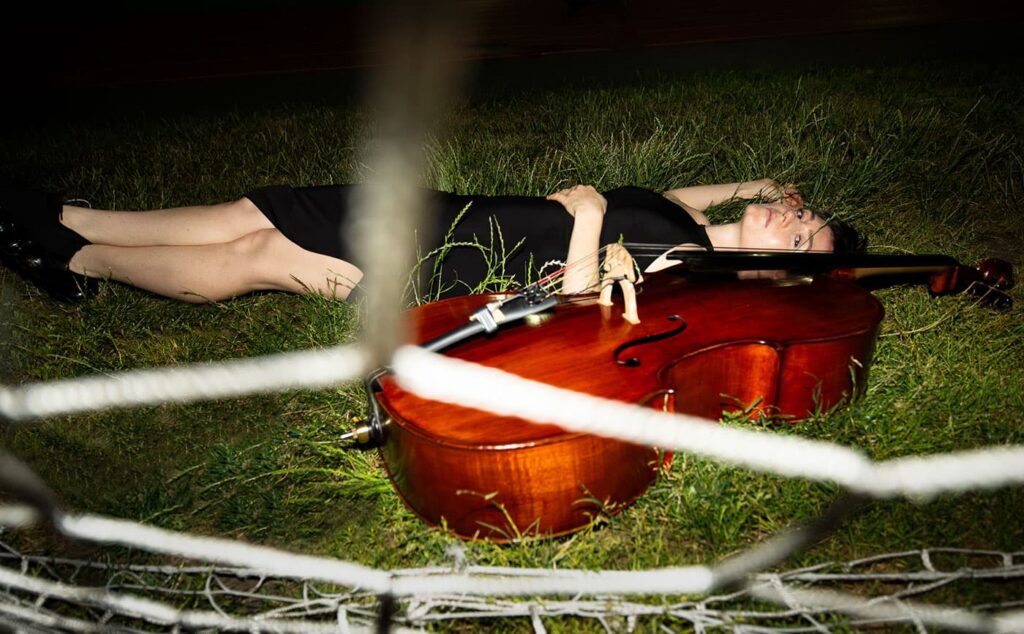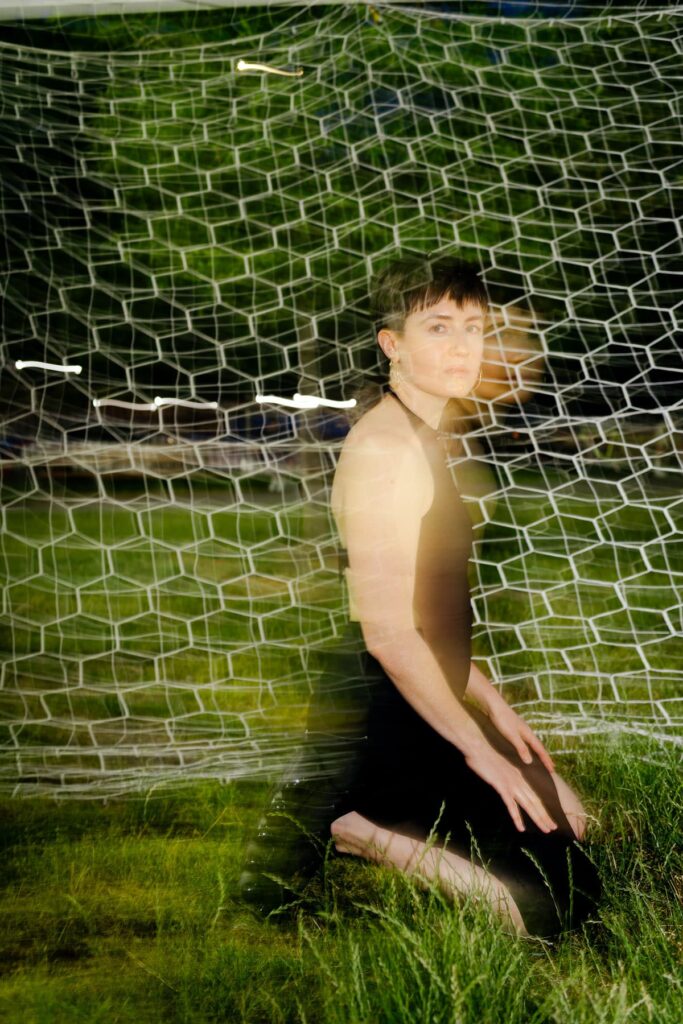
The barrage of new, often very good musical releases can sometimes be up to our eyeballs and bring the overwhelming feeling, that it can be far too much for our cognitive abilities. Even so, we stay on our toes and keep observing and exploring the musical scene, where among all this sounds and noises we still can come across real gems. And that’s precisely how an artist from Brooklyn, New York Kirin McElvain was discovered.
My editorial colleague, determined and enthusiastic gem seeker, Marek “Lokis” Nawrot suggested to me EP Viriditas. I instantly knew it must be something incredible.The cover itself was simply beautiful and imperceptible at the same time and made me curious instantly. After listening to just the first few sounds I immersed myself in an incredible, magical journey to Kirin’s realm. Immense landscapes and the universe began to emerge in front of my eyes and seemed to pull me right into it. From that very moment Viriditas became one of my TOP 10 releases in 2023.
At the beginning of January 2024 I also received an email from the artist herself, a thank you note for (modest in my eyes) support of her in Anxious. I couldn’t miss the boat and decided to ask her a few questions regarding her own artistic creations.
I strongly encourage you to read what she had to say and to first and foremost listen to this absolute masterpiece called Viriditas.
Artur Mieczkowski

Artur Mieczkowski: Hi Kirin. How did your adventure with experimental, improvised, and contemporary classical music begin?
Kirin McElwain: Growing up, my understanding of playing the cello and music-making in general was very much limited to the western classical music I studied in cello lessons and played in youth orchestras. I first became interested in contemporary classical (“new” music) in college. And I don’t feel like I became truly aware of experimental music or improvised music until maybe a few years ago – there’s so much fantastic work I am just discovering now for the first time.
A.M.: You explore the boundaries between formal structure and chaos within your sound and compositional practice. What do you mean by this, what purpose does it serve?
K.McE.: As a cellist, you’re trained to be an interpreter of music. And I really enjoy this aspect of playing. But all of my training was focused on adhering to an external aesthetic, particularly around what was considered “good” or “correct,” and I got to a point where I felt that I had lost touch with what I was interested in, or what I liked. I began working with synthesizers as a means of discovering what my own sensibilities might be, and also as a sort of antidote to aspects of my musical history where I didn’t have much agency or that felt really rigid.
There isn’t one correct approach to working with synths, and certainly no pedagogical or stylistic tradition that gets held up as “best” in the way that the western classical tradition is often held up as “best” within the classical community and in certain music circles. So I think a lot of my work is about exploring the space between what feels like polar opposite ways of listening, creating, and playing.
I’ll also say that I really enjoy mixing harsher textures with more ethereal ones, or metered through-composed elements next to noise. I think this push-and-pull between the more formally-organized sounds and the chaotic ones is an interesting place to explore.
A.M.: Your debut mini-album Viriditas has received critical acclaim. It’s also high in my personal TOP10 album summary and I’m delighted with this release. What were the inspirations and ideas behind this release?
K.McE.: Thank you so much for listening. My process for writing the music was basically to hit record and improvise while staying present with whatever I was experiencing in the moment. Those recordings became the basis for the tracks on the EP. Work for example, probably had 8 drafts before its current iteration. Other tracks, like Pacific Tell I & II and Letting were improvised basically in their final forms so that what’s on the record is either the original improvised track or very close to it. A lot of the process was me trying to figure out production and synthesis and composition in a very exploratory, self-directed way.
A.M.: During your time at Elektron Musikstudion in Stockholm, you worked with the halldorophone and the Buchla 200 system. How have these experiences influenced your approach to making music?
K.McE.: It was really special to have access to the studios at EMS, and to get to spend time with all these incredible instruments and have access to so many different mics and other gear, not to mention learning from the kind and knowledgeable staff there. I wouldn’t say that my time there changed or influenced my approach to making music, but it did make me realize that it’s possible for me to inhabit an entirely different role in the studio now than I could just a few years ago, when I was going into sessions simply as a cellist and didn’t possess any engineering or production skills.
During the writing process for Viriditas, I was recording and arranging simultaneously. I’ve recently been going back into the the EMS recordings, which means that I’m doing the editing and arranging process 7 or 8 months after making the recordings, so I suppose that’s a different way of working than with Viriditas. Sometimes I’m using the unedited recording as a standalone track, whereas other recordings I’m adding voice or cello or doing some minimal processing. And of course, listening back to these recordings, there are also feelings of, “oh I wish I had tried this or that,” in terms of wanting to change up mic placement or wishing I had asked more questions or tried different things, but I think it’s quite normal to feel that about any past work.

A.M.: With the cello, you play in concert halls as well as recording studios or DIY venues. What are the most important aspects of working in these different environments for you?
K.McE.: I don’t think I necessarily work differently based on the venue, though I certainly focus on different things in my preparation depending on what kind of music I’m playing. I’ll add that I’ve studied Alexander Technique for many years and it’s a pretty foundational aspect of how I approach playing and performing, as well as a really useful tool for navigating new and unfamiliar environments.
A.M.: Your collaborations on various music projects, including film and TV soundtracks, as well as with artists such as Post Malone, Ioanna Gika and This Will Destroy You. How different are these experiences for you?
K.McE.: Outside of making my own work, I’m almost always coming in as a hired cellist– usually there are charts already prepared, or the person who is hiring me already has a very specific vision of what they want from the cello part, so I wouldn’t consider it a collaboration per-se. But I do very much enjoy this kind of role, regardless of genre or application, because playing music with other people is the most fun I can possibly think of having. Though, I will add that whether or not it’s a positive experience really comes down to the people who are on the gig– if it feels good in the room, everyone’s going to play better. I feel extremely lucky that I’ve been able to work with some incredible artists who are also lovely people these past few years.

A.M.: What relevance does a background in classical music have for you in the context of your current artistic work?
K.McE.: I mean, in terms of the physical and technical aspects of playing the cello, a lot. I kind of quit practicing seriously the other year while I was making “Viriditas” – it just felt necessary to let the “cellist” side of me go for a bit in order to make space for this new practice I was developing. I’ve found that as I continue to make work, I’ve been wanting to get back into more regular practicing. Staying in shape feels good, it gives me more options, it makes me a better collaborator and improviser and performer.
In terms of writing music, I don’t listen to much recorded music of any kind. But I do think that years of only playing classical music does come out in my work, even if I’m not consciously referencing it.
A.M.: Do your experiences with multimedia installations, dance and classical concerts influence the way you approach your own musical projects?
K.McE.: Working with dancers has influenced how I improvise, for example responding to movement and gesture in the same way that I might respond to sound or the absence of sound.
A.M.: Your musical practice involves an experimental and improvisational approach. What discoveries have emerged during this exploratory process that have particularly influenced the development of your work?
K.McE.: I am learning to trust my instincts more; I have a better sense of when I’ve stumbled on something that’s working or when something isn’t finished, or needs to be reworked. I also think I have a much higher tolerance for vulnerability and discomfort; this has been very productive for me as a person and as a performer.
A.M.: Do you see any specific changes or evolution in your music in the coming years? Do you have any new concepts or inspirations that you intend to explore in upcoming projects?
K.McE.: I am most interested in continuing to pull the thread of making my own work and seeing where it leads me. But I’m certainly interested in writing music for film, composing for other instruments, and continuing to work on synthesis and singing.

A.M.: You are currently putting the finishing touches to two solo releases. Can you let us in on a bit of a secret about these projects?
K.McE.: One is more in the vein of “Viriditas”, and one is more halldorophone-focused.
A.M.: The final track Pacific Tell I & II from Viriditas, reminds me of COIL’s Solstice EPs. It contains just as much emotion and that moving beauty. This, of course, is not a reproach, quite the contrary. For me, the COIL recordings are some of the most beautiful I have heard and have changed a lot in my perception of music. With that, I wanted to ask you finally about your inspirations and the music that has revolutionized your approach to listening and creating.
K.McE.: I appreciate the reference to COIL! I’m not familiar with those particular EPs but will have to give them a listen.
In terms of the music that has influenced how I listen and create– for sure Sinead O’Connor, the Irish and Scottish traditional music I grew up listening to, Michael Gordon’s piece Industry for cello and distortion pedal, Pan Sonic, Aphex Twin, Pauline Oliveros, going to see live music as often as I can– I do my best to go out once or twice a week. And certainly spending time with my friends and family, getting into nature, running, and Alexander Technique all feel very essential to creating.
A.M.: Thank you very much for the interview and I wish you good luck with all your plans. I also hope that we can see you at a concert in Poland :).
K.McE.: It was a pleasure, thank you. And yes, I would love to come to Poland, hopefully soon!